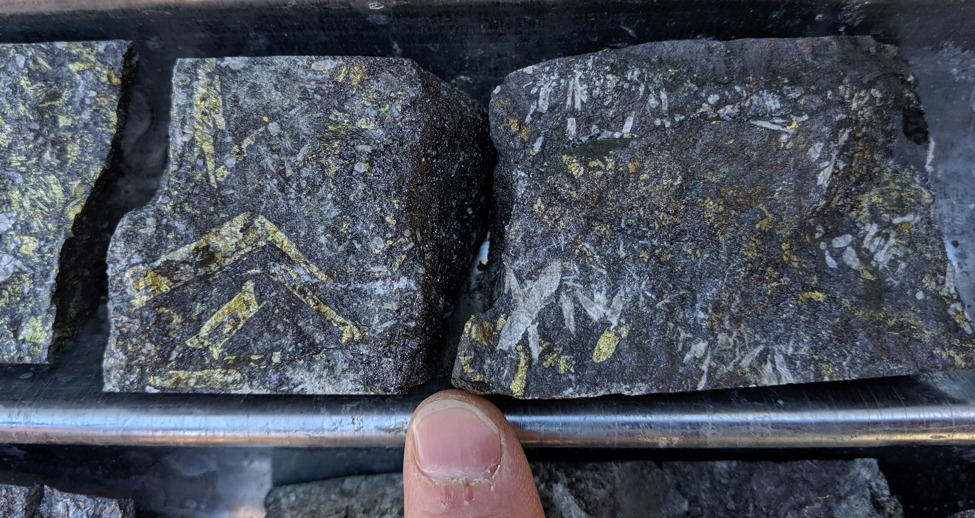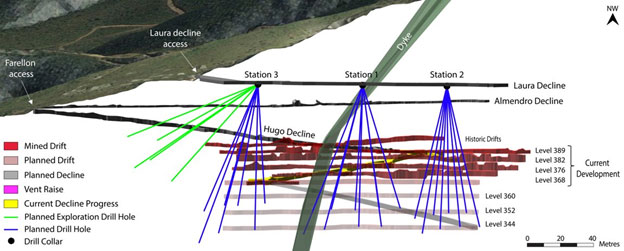Geology
The Farellon iron-oxide copper-gold (IOCG) Project is located 40 km southeast of La Serena, Chile. Farellon is within the coastal IOCG belt, a 50–80 km wide, N-S trending zone that extends over 1,000 km and hosts Cretaceous deposits such as Candelaria Complex, a 2 Bt Cu-Au-Ag deposit (826 Mt measured, 405 Mt indicated, 149 Mt inferred, and 655 Mt proven and probable)1 and Mantoverde a 1.4 Bt Cu-Au deposit (244.3 Mt a measured, 369.2 Mt indicated, 571.5 Mt inferred, and 235.7 Mt proven and probable)2.
IOCG deposits along the belt were formed mostly during mid-Cretaceous transtensional tectonism when plutonism was controlled by crustal-scale faulting that evolved into the Atacama Fault System (AFS), which is one of the primary controls on IOCG deposits in Chile. The hydrothermal origin for a significant number of the IOCG deposits including Candelaria, Mantoverde, and Farellon is likely magmatically derived fluids from spatially associated plutonic complexes.
Reference
1. Technical Report for the Candelaria Copper Mining Complex, Atacama Region, Region III, Chile, 2023 (lundinmining.com)
2. Mantoverde Mine and Mantoverde Development Project NI-43-101 Technical Report, Chanaral/Region of Atacama, Chile., 2021 (capstonecopper.com)
Mineralization
The Farellon project consists of a series of steeply dipping Fe-Cu-Au-rich veins. The main veins (Farellon, Laura, and Rosario) have a strike length of over 1.2 km, observable in outcrop and underground. The veins have widths of 1-10 m (~2 m average) and consist of early chlorite, actinolite, and apatite that have been largely replaced by magnetite, chalcopyrite, bornite, and gold mineralization.
Drill core from the Farellon Vein showing late chalcopyrite mineralization replacing bladed actinolite.
Metallurgy
Two 100 kg bulk samples of lower-grade material from Farellon were processed with the goal of improving copper recoveries and assessing the feasibility of producing an Fe-concentrate from the ore's abundant magnetite (currently gangue; see press release - April 4, 2019).
Initial copper and iron content of 100 kg metallurgical test samples
| Sample N° | %Fe (total) | % Cu (total) | % Cu (soluble) | Au ppm | Ag ppm |
| 251178 | 36.70 | 0.65 | 0.03 | 0.15 | 1 |
| 251179 | 33.70 | 1.11 | 0.04 | 0.09 | 1 |
Samples were crushed and milled before passing through magnetic separation drums. The resulting magnetite-rich concentrates indicate that a significant portion of the iron in the ore is recoverable and that the concentrate also retains the contained copper.
Copper and Iron content of the magnetic concentrate
| Sample N° | %Fe (total) | %Fe (magnetic) | %Cu (total) |
| 251178 | 69.32 | 66.70 | 0.61 |
| 251179 | 69.54 | 68.9 | 1.19 |
Production*
The Farellon mine has been operating intermittently since the 1970s. Historical production extended 70 m below ground and approximately 300,000 tonnes were extracted at an average grade of 2.5% copper and 0.5 g/t gold. This material was processed locally and sold to ENAMI.
Following Farellon's acquisition by Altiplano in 2017, a new decline (Hugo) was advanced parallel to the primary vein, approximately 50 m below the earlier workings. The Hugo decline was initially used to facilitate shallow underground diamond drilling and vein channel sampling. Initial results from both the drilling and channel sampling warranted the development of new drifts, predominantly at the 395 level. Development to date includes the Hugo decline advancing to the 389 m, 382 m, 376 m, 368 m, 360 m 352 m, 344 m and 336 m levels.
* The decision to commence production at Farellon is not based on a feasibility study of mineral reserves demonstrating economic and technical viability and there is increased uncertainty and economic and technical risks of failure associated with the production decision.
Diamond Drilling
Underground Drilling confirms the down-dip continuation of Cu-Au mineralization below the current mining operations (see news release Jan 13th, 2022). Significant intercepts include 3.18% Cu over 3.67 m, 2.97% Cu over 4.86 m and 3.24% Cu over 2.68 m (true width estimated at 70-80% of reported core length). These results are similar to other deep-rooted IOCG systems in the area, including the Tambillos Mine located 3.5 km south, which has been in production for over 50 years and is currently mining 1.2 km underground.
The 2021 diamond drill program was designed to assist with grade control and determine mineralization continuity for the ongoing Hugo Decline advancement. Assay results from the 2021 drill program confirm that Farellon's IOCG-type mineralization continues to depth and further highlights the expansion potential additional exploration drilling can provide.


